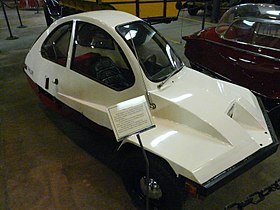| H-M-Vehicles Free-Way | |
|---|---|
 | |
| Overview | |
| Manufacturer | H-M-Vehicles Inc. |
| Production | 1979–1982 |
| Assembly | Burnsville, Minnesota |
| Designer | Dave Edmonson |
| Body and chassis | |
| Class | Microcar |
| Body style | Coupe |
| Layout | RMR layout |
| Related | D&A Minikin |
| Powertrain | |
| Engine | Tecumseh single-cylinder engine *12 hp model: 345 cc (21.1 cu in) *16 hp model: 453 cc (27.6 cu in) permanent magnet DC motor, 4 hp |
| Transmission | CVT, no reverse gear |
| Dimensions | |
| Length | 115 in (292 cm) |
| Width | 53 in (135 cm) |
| Height | 51 in (130 cm) |
| Curb weight | gasoline: 700 lb (318 kg) electric: 900 lb (408 kg) |
The H-M-Vehicles Free-Way (H-M meaning high mileage) was a three-wheel microcar manufactured in Burnsville, Minnesota, from 1979 to 1982.

These small commuter cars had a single seat and were powered by a 12 or 16 hp (9 or 12 kW) gasoline engine or a 4 hp electric motor. A diesel engine was offered, but none were ordered with it.
The 12 HP version was guaranteed to get 100 mpg‑US (2.4 L/100 km; 120 mpg‑imp) when driven at a steady 40 mph (64 km/h). The 12 HP version averaged 80 mpg‑US (2.9 L/100 km; 96 mpg‑imp), and the larger 16 hp averaged 60 mpg‑US (3.9 L/100 km; 72 mpg‑imp) to 70 mpg‑US (3.4 L/100 km; 84 mpg‑imp). The standard fuel tank had a capacity of 3 US gallons (11 L) while a 10 US gallons (38 L) tank was optional.
The engine was mounted behind the driver and was coupled to a snowmobile-style CVT belt drive transmission. Final drive to the rear wheel was by chain. The gasoline-powered Free-Way did not have a reverse gear in its transmission. An electrically powered reverse drive was offered as an option, but was never made available.

The Free-Way had a welded tubular steel frame, with a secondary perimeter frame at bumper height to protect the driver from impacts. Suspension was fully independent, with two wheels in front and a single wheel in the rear. The fully enclosed two-piece fiberglass body was approximately 0.125 inches (3.2 mm) thick and had the color molded into the material and was available in high-visibility red, yellow, or orange. The lower body included a full undertray to reduce the drag coefficient of the vehicle.
The Free-Way had a single headlight and per federal standards were intended to be licensed as a motorcycle, but in some states they were titled as cars.
About 700 Free-Ways were sold before the company closed in June 1982.
See also
References
- ^ "HM Vehicles Freeway". 3-Wheelers.com. Archived from the original on 2017-03-05. Retrieved 2011-11-05.
- ^ "High Mileage Vehicles - A New Technology: Page 6". Clubs.hemmings.com. Archived from the original on 2011-09-27. Retrieved 2011-11-05.
- ^ Frey, Peter (December 1979). Dianna, John (ed.). "Driving Impression - "Free-Way" Commuter". Motor Trend. Vol. 31, no. 12. Los Angeles, CA: Petersen Publishing. pp. 44–45. ISSN 0027-2094.
- ^ "Leo's Garage: Free-Way Maintenance". Leostoys.com. Retrieved 2011-11-05.
- "Tim Medeck's 1981 H-M Vehicles Freeway". Evalbum.com. 2004-03-16. Retrieved 2011-11-05.
- ^ "High Mileage Vehicles - A New Technology: Page 5". Clubs.hemmings.com. Archived from the original on 2011-09-27. Retrieved 2011-11-05.
- "The Freeway Newsletter Vol. 1 No. 5, June 1981" (PDF). Retrieved 2011-11-05.
- "High Mileage Vehicles - A New Technology: Page 9". Clubs.hemmings.com. Archived from the original on 2011-09-27. Retrieved 2011-11-05.
External links
- groups.yahoo.com/neo/groups/freewayhmv/info — HM Vehicles Free-Way Yahoo! discussion group
- Free-Way Reunion, Autos & Parts For Sale
- The HM-Vehicles Freeway is the Lawn Mower Powered Three-Wheeler of Your Dreams on YouTube (published 2019-09-26)